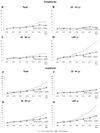|
|
| 1. |
Ried LD, Johnson RE, Brody KK, Vogt TM. Medical care utilization among older HMO members with and without hypertension. J Am Geriatr Soc 1995;43:222–229.
|
|
| 2. |
Ministry of Health and Welfare. 2008 National health statistics: 4th Korean National Health and Nutrition Survey (2008). 2009. pp. Seoul-Ministry of Health and Welfare.
|
|
| 3. |
Kearney PM, Whelton M, Reynolds K, Muntner P, Whelton PK, He J. Global burden of hypertension: analysis of worldwide data. Lancet 2005;365:217–223.
|
|
| 4. |
Yoon SJ, Ha BM, Kim C. Measuring the burden of hypertension using DALY in Korea. Korean J Health Policy Adm 2001;11:89–101.
|
|
| 5. |
Health Insurance Review & Assessment Service. Statistical report. Seoul: Health Insurance Review & Assessment Service; 2010.
|
|
| 6. |
Kim SG, Kim S, Park W. Prevalence and management status of hypertension in Korea. J Korean Soc Hypertens 2006;12:7–15.
|
|
| 7. |
Doh SR. Transition of the change of medical utilization in Korea. Health Welf Issue Focus 2009;8:1–8.
|
|
| 8. |
Doh SR. Medical utilization of the aged: issues and policy tasks. Health Welf Policy Forum 2009;(157):66–79.
|
|
| 9. |
Ministry of Health and Welfare. 2008 National patient survey. Seoul: Ministry of Health and Welfare; 2009.
|
|
| 10. |
King DE, Ellis TM, Everett CJ, Mainous AG 3rd. Medication use for diabetes, hypertension, and hypercholesterolemia from 1988-1994 to 2001-2006. South Med J 2009;102:1127–1132.
|
|
| 11. |
Wu PH, Yang CY, Yao ZL, Lin WZ, Wu LW, Chang CC. Relationship of blood pressure control and hospitalization risk to medication adherence among patients with hypertension in Taiwan. Am J Hypertens 2010;23:155–160.
|
|
| 12. |
Kim JS, Lee HC, Yoo WS, Yoo UH. Mean blood pressure, prevalence and epidemiologic characteristics of hypertension among representative Korean adult population. J Korean Soc Hypertens 1998;4:89–98.
|
|
| 13. |
Lee YJ, Nam CM, Kim HC, Hur NW, Suh I. The association between obesity indices in adolescence and carotid intima-media thickness in young adults: Kangwha Study. J Prev Med Public Health 2008;41:107–114.
|
|
| 14. |
Choi DP, Lee JY, Ahn V, Kim HC. Association between pulse pressure and carotid intima-media thickness in healthy adolescents: Jangseong High School Study. J Korean Soc Hypertens 2012;18:29–37.
|
|
| 15. |
Song H, Jan S, Shin S. Patterns of medical care utilization behavior and related factors among hypertensive patients: follow-up study using the 2003-2007 Korean health insurance claims data. Korean J Health Educ Promot 2012;29:1–12.
|
|
| 16. |
Johnson RE, Ried LD, Vogt TM. Comparing health-related indicators of very old hypertensives and nonhypertensives in an HMO. J Aging Health 1994;6:535–548.
|
|
| 17. |
Park JK, Kim KS, Kim CB, Lee TY, Lee K, Lee DH, et al. The accuracy of ICD codes for cerebrovascular diseases in medical insurance claims. Korean J Prev Med 2000;33:76–82.
|
|




 ePub
ePub Citation
Citation Print
Print









